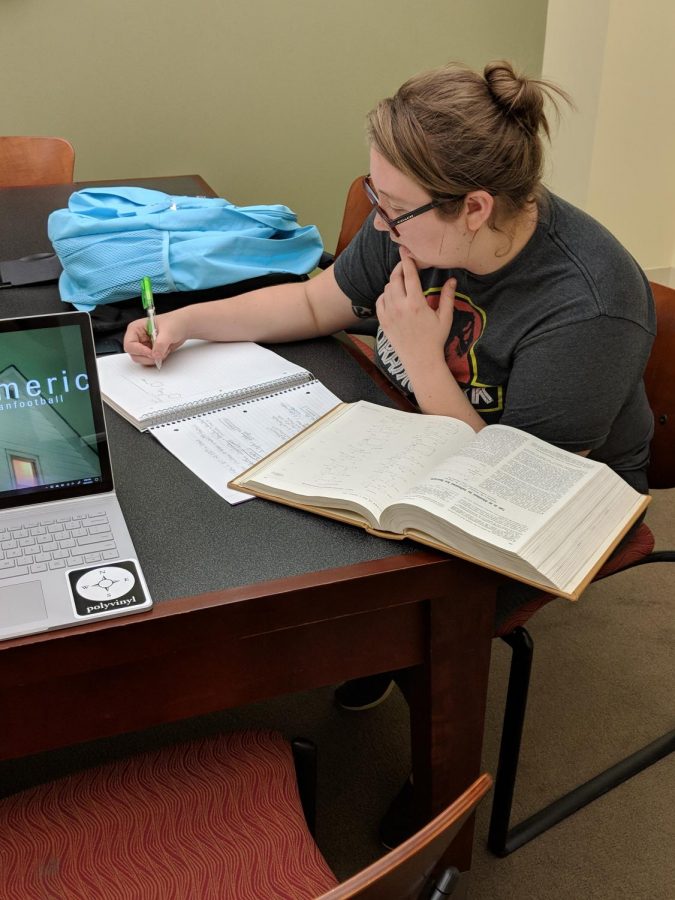Note-Taking Techniques
Type them up or write them by hand — either way, note-taking is essential for success in college. But what’s the best method, and why?
Katie McKoy, General Studies Major and junior, completes an online assignment. Photo by Bryce Shreve
September 19, 2018
Casual banter trails off as the professor enters the room. A hush falls over the class as the dreaded Chapter One slideshow appears on the board. Students — well, most students — quickly reach for their notebooks. But in the digital age, not all notebooks are made from dead trees. Although there are environmental benefits to using technology to take notes, there may be educational detriments.
The tools available to college students have changed substantially, thanks to the rapid advancement of technology. Instead of having to fill physical notebooks with graphite-on-paper notes, students have the option to type their notes and save them to the cloud.
Kacey Walker, a general studies freshman, writes her notes by hand more often than she types them. She said that she may type notes depending on how the professor lectures, but writing things down is her main method.
“I know that writing things down will help most people remember things more clearly, which is why it is my go-to way of taking notes,” Walker said.
Katie McCoy, a junior in Chemistry, currently writes all of her notes by hand.
“I do handwritten notes,” McCoy said. “I find it’s easier since I study chemistry and take a lot of math classes and I have to draw a lot of stuff, which isn’t easy to do on a laptop.”
While her loyalties lie with paper and pencil, Katie said she’s considering the switch to digital notes.
“I have a 2-in-1 and I could get a pen to use with it,” McCoy said. “I know there are apps you can use and I wonder if [taking notes] would be faster on that.”
Katie is in luck. Apps like EverNote, OneNote, and Simplenote are easy to use and loaded with features that engage the user in thorough note-taking.
But the ascent of digital note-taking may have come at the expense of the note-taker’s retention of the material, according to a study published in 2014.
In their study, The Pen Is Mightier Than the Keyboard, Pam Mueller and Daniel Oppenheimer found that students who wrote their notes by hand demonstrated significantly better memory retention than students who typed their notes.
Mueller and Oppenheimer’s findings showed that when students were writing notes by hand, they had to be more selective in what they wrote down, because — generally — writing by hand is more time-consuming than typing. Being more selective led to improved retention.
Typing notes, they discovered, frequently resulted in the student transcribing what they saw or heard verbatim, while not actively processing the information they received.
However, they found that a benefit of typing notes verbatim was that the student is able to look back on more complete and transcribed notes for studying purposes.
Considering Mueller and Oppenheimer’s study, and the pros and cons of handwritten notes and typed notes, what is the best way to take notes? Donna Albrecht, an associate professor of education, said students don’t always know the best ways to take notes and are left to figure it out.
“I’ve noticed in my career that a lot of times, students haven’t really been taught proper note-taking and we’ve kind of left them up to their own devices to figure out what works for them,” Albrecht said.
Albrecht said that it comes down to “personal style” when students consider how they should take notes. She added that professors have some responsibility to provide a structure that helps students take good notes, no matter their method.
Studies have proved that handwritten notes result in higher memory retention when compared to typed notes. However, this is not an absolute truth, since typed notes are often more in-depth and useful to look over at a later date.
As Professor Albrecht said, it all comes down to personal preference. Be it intricate note-taking apps on a laptop, or the tried-and-true #2 pencil and a fresh piece of paper, taking notes is a major key to success in college.



